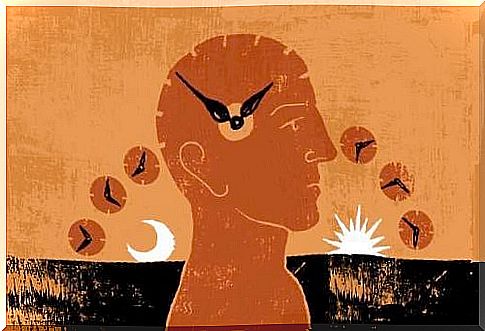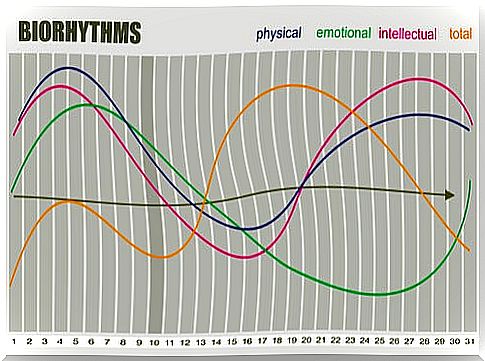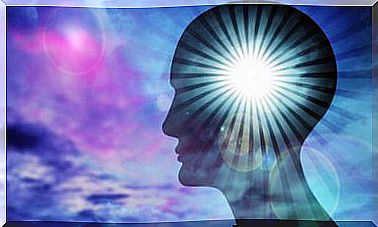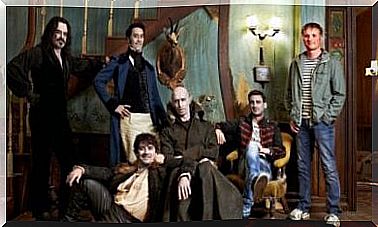The Swoboda-Fliess-Teltscher Law And Biological Cycles

The Swoboda-Fliess-Teltscher Law, better known as “biorhythm,” became very popular during the 1970s. It actually laid its foundations at the end of the 19th century, but it was not until well into the 20th century that it acquired notoriety and began to be taken for granted. In fact it was and continues to be applied in many places.
According to the Swoboda-Fliess-Teltscher Law, people have biological cycles of three types. One of them is a physical cycle, which lasts 23 days. The other is an emotional cycle, which lasts for 28 days. Finally, the theory indicates that we have an intellectual cycle that lasts 33 days.
Such cycles would be present from the moment of birth. The Swoboda-Fliess-Teltscher Law states that such cycles have an upward and downward curve. At the top of the curve, physical, emotional or intellectual capacity is at its peak. Meanwhile, at the lowest points, each capacity decreases to a minimum. When two or more of these low points coincide on the same date, we speak of a “critical day”.
The creators of the Swoboda-Fliess-Teltscher Act
The creators of the Swoboda-Fliess-Teltscher Law were Wilhem Fliess, Alfred Teltscher, and Herman Swoboda. The latter was the one who gave the final shape to the “biorhythms” and that is why this law is also known as Swoboda’s Law.

Wilhem Fliess was a German physician, patient, and personal friend of Sigmund Freud . He was the first to mention that he had observed regularities at certain intervals. He spoke of them as a kind of “internal biological clock.” He described the physical and emotional cycles. Fliess maintained a particular bond with Freud and also created strange theories. Among them, a rare association between the genital organs and the nose.
For his part, Alfred Teltscher was an Austrian researcher, who served as a professor of mechanical engineering at the University of Innsbruck. He became interested in Fliess’s theories and decided to test them for himself with his students. Not only did he corroborate such theories, but he also added a new cycle: the intellectual one.
Finally, Herman Swoboda was a psychologist and professor at the University of Vienna. He studied the subject of biorhythms for several years and, like Telscher, believed he discovered very well defined intellectual cycles in his students. It was he who gave the final form to the Swoboda-Fliess-Teltscher Law.
The popularization of biorhythms
Although the theory had long been complete, it was in the 1970s that a man named Bernard Gittelson published several books on the subject. At that time, the postulates of the so-called “New Age” were becoming popular. The public was very receptive to the theories of biorhythm, which emerged on the basis of the Swoboda-Fliess-Teltscher Law.
Biorhythms had a time when they became a real hit. In the United States, places to do the biorhythm began to become popular and computer programs were also produced for it.
The business world was no stranger to this trend. United Airlines is known to have used biorhythms for the purpose of avoiding human error during its flights. Similarly, thousands of companies joined the wave, as Gittelson’s books gave guidelines for improving work productivity based on cycles.
Time-honored lies and pseudoscience
Biorhythms and the Swoboda-Fliess-Teltscher Law are one of the most paradigmatic examples of popularized pseudoscience. Although the theory was viewed with suspicion from the beginning in the scientific media, it was not until 1998 that neurologist Terence Hines conducted a long-term study of it. His conclusion was that there were no such cycles.

Hines denounced that the observations and theorizations on which the Swoboda-Fliess-Teltscher Law had been built were completely arbitrary. They did not apply the scientific method and gave conjectures the value of conclusions. The belief in biorhythms made people make free associations between what happened to them and what that instrument said. With or without bases, they ended up giving validity to facts that were explained by chance.
Hines also found that physical, emotional and intellectual cycles do not exist. Obviously in humans there are physiological and hormonal cycles, but this has nothing to do with productivity, or critical days, or anything like that. Despite the evidence presented, many people around the world still believe in biorhythms.









